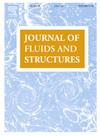Modelling unsteady hydrodynamic gust loading on tidal turbine blades
IF 3.5
2区 工程技术
Q1 ENGINEERING, MECHANICAL
引用次数: 0
Abstract
This study investigates the blade loads on a model tidal turbine subject to unsteady gust forcing in the form of uniform small-amplitude oscillations in the axial inflow velocity. The validity of industry-standard 2D strip-theory models for calculating unsteady hydrodynamic loading on 3D rotor geometries is evaluated by comparing the 2D results to 3D simulations, both Reynolds-Averaged Navier Stokes (RANS) simulations and 3D inviscid vortex lattice modelling (VLM). The results show that the 2D function captures neither the trends nor the magnitudes of the unsteady turbine loads, which exceed the quasi-steady loads. The inviscid VLM corresponds more closely to unsteady RANS simulations, suggesting that 3D wake effects are a primary driver of the unsteady loads. A key non-dimensional parameter determining the unsteady load magnitudes is identified as the ratio of gust frequency to blade passing frequency. Finally, it is demonstrated that applying conventional tip-loss corrections to 2D unsteady hydrodynamic load models can in some circumstances lead to severely under-predicted blade loads. These outcomes have implications for the evaluation of peak and lifetime loads on tidal devices, and for any rotor application which relies on 2D strip-theory methods for unsteady load evaluation.

潮汐涡轮叶片非定常流动力阵风载荷建模
本文研究了非定常阵风强迫作用下模型潮汐水轮机叶片载荷在轴向入流速度上的均匀小振幅振荡。通过将二维计算结果与三维模拟结果、reynolds - average Navier Stokes (RANS)模拟和三维无粘涡晶格模型(VLM)进行比较,评估了工业标准二维条形理论模型用于计算三维转子几何非定常水动力载荷的有效性。结果表明,二维函数既不能反映非定常涡轮负荷的变化趋势,也不能反映非定常涡轮负荷的大小,而非定常涡轮负荷大于准定常涡轮负荷。非粘性VLM更接近非定常RANS模拟,表明三维尾迹效应是非定常载荷的主要驱动因素。确定了决定非定常载荷大小的关键无量纲参数为阵风频率与叶片通过频率之比。最后,研究表明,将传统的叶尖损失修正应用于二维非定常水动力载荷模型在某些情况下会导致叶片载荷严重低估。这些结果对潮汐装置的峰值和寿命负荷的评估以及依赖于二维条形理论方法进行非定常负荷评估的任何转子应用都具有重要意义。
本文章由计算机程序翻译,如有差异,请以英文原文为准。
求助全文
约1分钟内获得全文
求助全文
来源期刊

Journal of Fluids and Structures
工程技术-工程:机械
CiteScore
6.90
自引率
8.30%
发文量
173
审稿时长
65 days
期刊介绍:
The Journal of Fluids and Structures serves as a focal point and a forum for the exchange of ideas, for the many kinds of specialists and practitioners concerned with fluid–structure interactions and the dynamics of systems related thereto, in any field. One of its aims is to foster the cross–fertilization of ideas, methods and techniques in the various disciplines involved.
The journal publishes papers that present original and significant contributions on all aspects of the mechanical interactions between fluids and solids, regardless of scale.
 求助内容:
求助内容: 应助结果提醒方式:
应助结果提醒方式:


